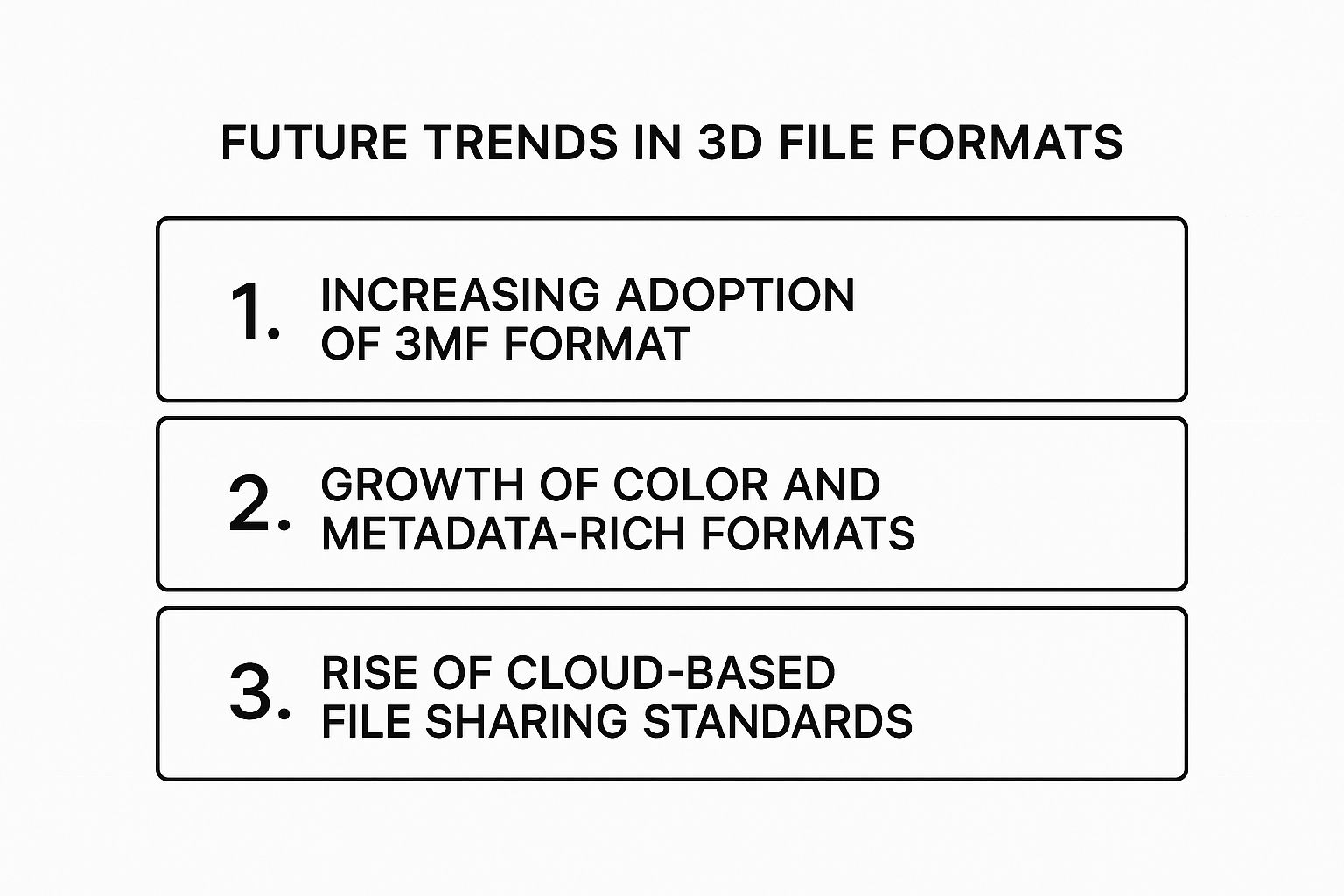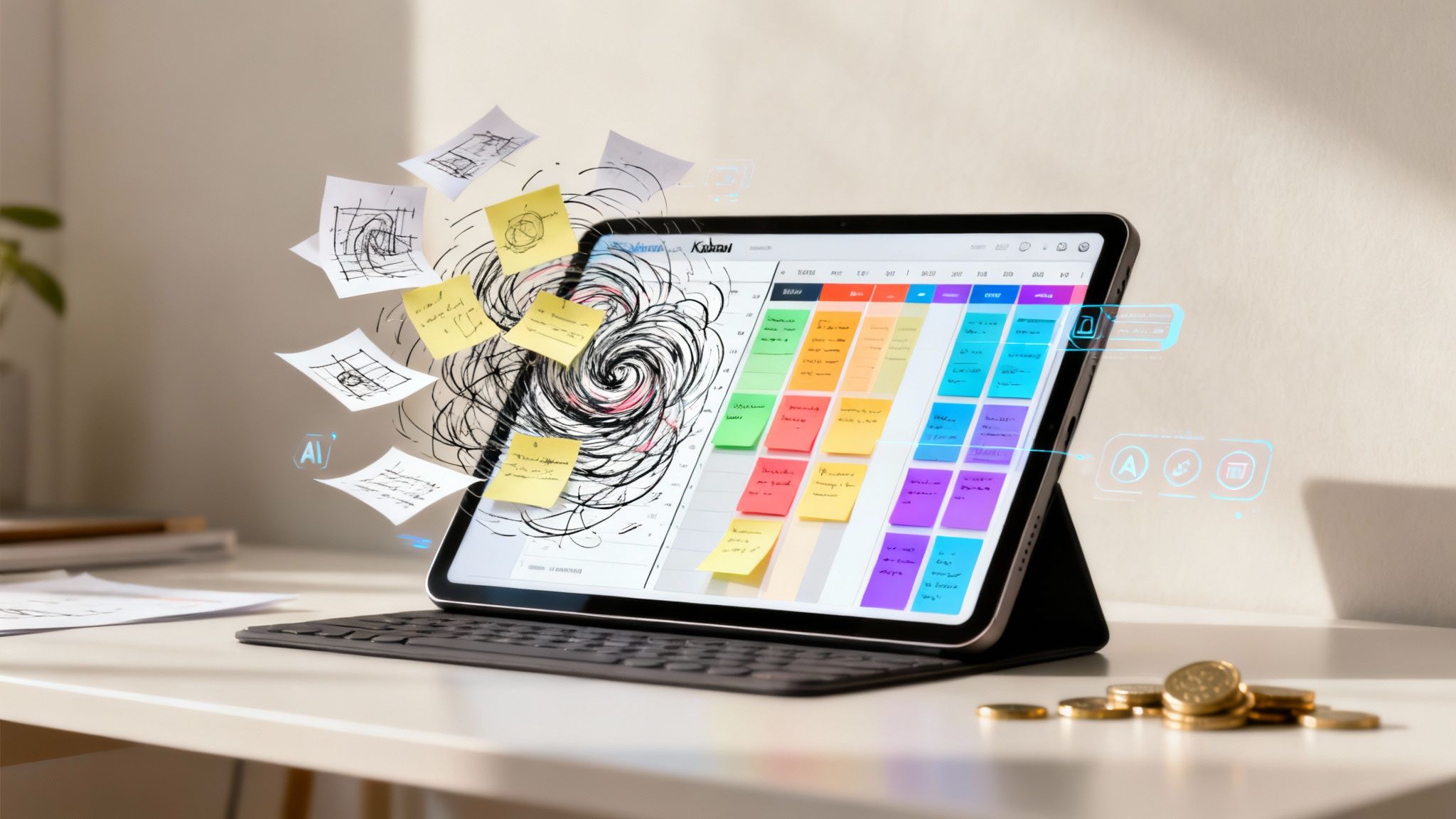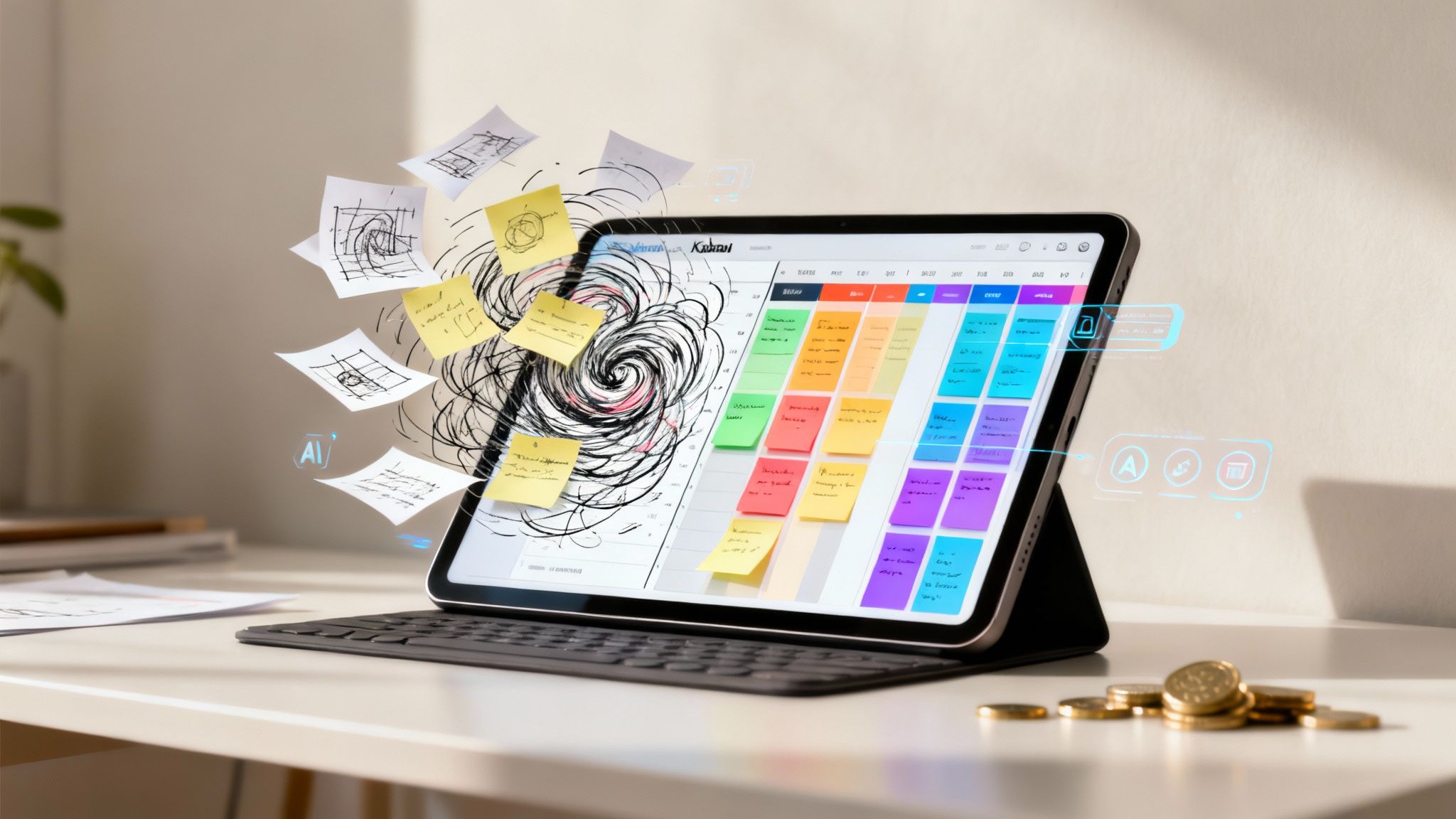Think of 3D printing file formats as the universal language between your digital design and the physical printer. They are the official blueprints that translate every curve, color, and detail from your screen into a tangible object. The most common formats you'll encounter are STL, OBJ, and 3MF, each with distinct capabilities suited for different professional applications.
What a 3D Printing File Actually Does
At its core, a 3D printing file is a digital container holding all the information a printer needs to build a physical object. It serves as the final, non-negotiable instruction set. Without this data, the printer is simply a collection of components with no directive.
The process is analogous to printing a document. A PDF contains text, formatting, and images; a 3D file holds geometric data—and often much more.
When you initiate a "print," a slicer software interprets the file and divides the model into hundreds or thousands of ultra-thin horizontal layers. The printer then executes these instructions, building the object one layer at a time with precision.
Why Choosing the Right Format Matters
Selecting the correct file type is not merely a technicality; it directly influences the quality, accuracy, and security of your final print. This single decision can impact several critical aspects of your project:
- Geometric Precision: How accurately the file captures complex shapes and fine details.
- Color and Texture Data: Whether the file only stores the shape or also holds visual information like color and material finish.
- File Size and Efficiency: How the file's size affects processing time, storage, and data transfer.
- Data Security: The ability to embed intellectual property information, which is essential for professional and enterprise use.
For those just beginning to explore this process, our guide on how to create 3D models offers a foundational overview of turning a concept into a digital asset.
The development of standardized, reliable 3D printing file formats is a key factor in the industry's significant growth. Efficient and secure data transfer is the engine powering a market that is expanding into nearly every professional field.
This is no longer a niche technology. The global 3D printing market, which depends on these files, was valued at USD 20.37 billion in 2023. It’s projected to reach over USD 88.2 billion by 2030, driven by high adoption in sectors like aerospace and healthcare where file integrity and compliance are paramount. Discover more insights about 3D printing industry growth.
Understanding these formats is not just about improving a print—it’s about integrating into a manufacturing revolution that demands precision, security, and compliance.
Understanding STL: The Original Workhorse

When people discuss 3D printing files, they are often referring to the STL format. Released in 1987, the Stereolithography (STL) file is the foundational format of 3D printing.
Consider it the plain text file in a world of complex documents—it's simple, reliable, and almost universally compatible.
How does it function? The format describes a 3D model’s surface using a method called tessellation. This process covers a smooth 3D object with a mesh of small, flat triangles. The STL file is a comprehensive list of the coordinates for the vertices of each triangle, effectively mapping the model's surface geometry.
The higher the number of triangles used, the smaller they become, resulting in a mesh that more closely approximates the original smooth surface. This is why a highly detailed model generates a large STL file—it contains more triangle data to capture intricate features.
The Power of Simplicity and Compatibility
The primary advantage of the STL format is its straightforward simplicity. It contains only geometric data, meaning that nearly every 3D printer and software application developed over the past three decades can read it without issue.
This universal compatibility makes it a safe and dependable choice for basic applications.
If you are printing a single-color mechanical part, a basic architectural model, or a rapid prototype, STL is often the most direct path from digital design to physical object. You can send an STL file to a colleague or client with confidence that they can open and use it.
This is a significant benefit for hobbyists, educators, and professionals who require a format that is guaranteed to work for simple tasks. No extra files, no complex settings—just the core shape.
The Limitations of a Geometry-Only Format
However, this simplicity is also the STL's greatest weakness. It contains only the surface geometry. All other rich data from your design is discarded.
This means you lose critical information for professional visual work, including:
- Color Data: An STL has no capacity for color information, making it unsuitable for multi-color or full-color 3D printing.
- Material Info: You cannot assign different materials to different parts of a model within a single STL file.
- Texture Maps: All detailed surface textures from your original design are lost.
- Metadata: Information such as author details, intellectual property rights, or print settings cannot be included.
An STL file is a ghost of a 3D model. It perfectly describes the shape, but it has no substance. All the color, texture, and life you put into your original design are left behind.
Because of these limitations, an STL file can be frustratingly ambiguous. It does not store units (e.g., millimeters vs. inches), which can lead to incorrect scaling by the slicer software. Furthermore, the format lacks built-in error checking, making it easy to generate files with holes or overlapping triangles that can compromise a print.
For serious creative or enterprise applications, these drawbacks often make it an unsuitable choice.
Adding Visual Richness with OBJ Files

While an STL provides a solid blueprint for an object's shape, it is entirely devoid of color information. For anyone in visual design, art, or marketing, geometry is only part of the story. The true impact often lies in the color, texture, and material—and this is where the OBJ file format becomes relevant.
Developed by Wavefront Technologies for its animation software, the OBJ (or .obj) format was designed for visual artists. It uses a polygon mesh to define an object’s shape, similar to an STL. The key distinction is its ability to store data beyond basic geometry.
This is a crucial capability for creative work. Consider designing a character for a video game, mocking up a realistic product for a marketing campaign, or creating a piece of digital art. The texture of leather, the sheen of metal, the precise shade of a color—these details are essential. The OBJ format was designed to carry this vital visual information.
Beyond Geometry with MTL Files
How does an OBJ handle this additional data? The solution lies in a companion file: the Material Template Library (.mtl).
Think of it this way: the OBJ file is the raw sculpture, and the MTL file provides the complete set of paints and finishes. The OBJ defines the shape, while the MTL instructs the software on what color to apply to each surface, how shiny it should be, and what patterns to use.
This companion file works in tandem with the main OBJ model. Inside the MTL, you can define attributes such as:
- Color: The specific diffuse, ambient, and specular colors of a surface.
- Transparency: How transparent an object or a specific part should be.
- Reflectivity: Whether a material appears glossy and reflective or dull and matte.
- Texture Maps: Links to external image files (e.g., JPG or PNG) that are wrapped around the model to create detailed patterns like wood grain, fabric weaves, or corporate logos.
To apply these image files correctly to a 3D shape, designers use a process called UV mapping. This technique essentially "unwraps" a 3D model into a 2D map so a flat texture can be applied without distortion. We cover this in more detail in our guide on what is UV mapping. This collaboration between OBJ, MTL, and texture files has made the format a long-standing choice in animation and visual effects.
Practical Drawbacks in Production Pipelines
Despite its visual strengths, the OBJ format can introduce challenges in a professional production pipeline. Its most significant weakness is its fragmented nature.
A single "complete" model may consist of a bundle of files: the main OBJ, its MTL companion, and a folder of separate image textures. Managing this for one asset can be cumbersome; scaling it across a project with hundreds of assets introduces significant risk.
This dependency on multiple external files is a huge point of failure. If a texture file gets moved, renamed, or deleted, the link breaks. Suddenly, your beautifully textured model renders with a big, ugly gray patch. This is a massive vulnerability in any serious, enterprise-level workflow.
Additionally, OBJ files are text-based, which can result in very large file sizes for high-polygon models, making them slow to load and share. While excellent for visual work, this fragmented structure is not ideal for the streamlined, single-file workflows required for modern 3D printing and digital asset management.
Still, its accessibility maintains its popularity. The global personal 3D printers market, valued at USD 2,552.10 million in 2024, benefits from easy-to-use formats like OBJ and STL for a range of applications. You can read the full research about the growing personal 3D printing market to understand the continued relevance of these file types.
Diving Into the Modern 3MF Format
Anyone who has struggled with an STL's limitations or managed an OBJ with its separate texture files understands the frustration. One format is too basic, while the other can be unwieldy. They either discard critical information or force you to manage a folder of files just to print a single part correctly.
This is precisely the challenge that the 3MF (3D Manufacturing Format) was designed to solve.

The image above from the 3MF Consortium illustrates the collaborative effort behind this format. Industry leaders like Microsoft, Autodesk, and Ultimaker joined forces to create an open-source standard designed for modern workflows. Their goal was not just another file type but a reliable foundation for contemporary additive manufacturing.
Think of a 3MF file less like a blueprint and more like a complete project-in-a-box. It functions similarly to a ZIP archive, bundling every piece of data about your model into one tidy, self-contained package. This approach is designed from the ground up for today's complex 3D printing environments.
The All-In-One Project Package
The true innovation of 3MF is its ability to contain much more than just geometry. When you export a 3MF file, you are not just saving a shape; you are capturing the entire design and manufacturing intent in a single, unambiguous file.
Here's what this "project-in-a-box" can hold:
- Complete Geometry: The core 3D mesh, similar to an STL or OBJ.
- Color & Material Data: Specifies exact colors, textures, and material assignments directly within the file, eliminating the need for separate .MTL or texture map files.
- Print Settings: Slicer configurations like support structures, layer height, and infill can be embedded, ensuring your part prints consistently every time, on any compatible machine.
- Thumbnails & Metadata: Includes author information, copyright details, and a preview image, which is invaluable for digital asset management.
By consolidating everything into one file, 3MF eliminates the risk of broken links to textures or mismatched print profiles. It creates a far more robust and secure workflow—a non-negotiable requirement in professional settings where a failed print equates to lost time and resources.
The 3MF file is essentially a self-aware digital twin of your intended physical object. It doesn't just describe the shape; it carries the full manufacturing recipe, ensuring what you design is exactly what you get.
This all-in-one approach also leads to much smaller file sizes. Because 3MF can reference a single mesh multiple times for identical objects, it avoids the massive data duplication that inflates STLs. For complex assemblies, this can reduce file sizes by more than 50%, making models easier to store, share, and process.
Built for Enterprise Reliability and Security
Beyond convenience, 3MF was engineered with professional needs at the forefront. One of its key features is its crystal-clear, unambiguous definition of a model's properties. For instance, 3MF files always include unit information (such as millimeters or inches), eliminating the guesswork in scaling.
The format also has error prevention built in. The 3MF specification is strict about what constitutes a "manifold" or printable mesh. It is fundamentally impossible to create a valid 3MF file with the non-manifold edges or intersecting faces that frequently cause issues in STLs, dramatically reducing print failures.
This built-in reliability is a major driver of its growing adoption. As the global 3D printing market is projected to reach USD 101.74 billion by 2032, advanced formats like 3MF are essential for dependable data exchange. You can explore the data in these projections for the 3D printing market.
For designers, this means more time creating and less time troubleshooting corrupted files. For businesses, it translates to a more predictable, compliant, and secure manufacturing pipeline from start to finish.
How to Choose the Right File Format
Selecting the right 3D printing file format is like choosing the appropriate shipping container. Some are simple, no-frills steel boxes, while others are refrigerated or high-security for specialized cargo. The correct choice depends entirely on the contents. The same principle applies to 3D files.
For a hobbyist printing a single-color miniature, the universal simplicity of an STL is perfectly adequate. It just works. However, for a product designer sending a multi-part prototype with specific material and compliance instructions to a manufacturer, a much more robust format is required.
In that professional scenario, a 3MF file is the only appropriate choice. It packages everything—geometry, color, materials, and even intellectual property information—into a single, secure file. This ensures the final printed object precisely matches the design intent, which is critical when accuracy and compliance are paramount.
Comparing Key Features of 3D Printing File Formats
To clarify the decision-making process, here is a breakdown of the core differences between the three main formats. This serves as a quick reference for matching the format to your project's requirements, balancing simplicity against functionality.
This table illustrates a clear evolution. STL is the foundational format, OBJ adds visual capabilities but creates file management complexities, and 3MF delivers a complete, modern solution built for professional and enterprise workflows. The format you choose directly impacts the efficiency, security, and reliability of your entire process.
Practical Scenarios and Best Practices
Understanding the technical specifications is one thing, but applying them to real-world scenarios makes the decision easier. Let's consider a few common examples.
- Architectural Mockups: An architect printing a simple, single-color building model to verify its form would likely use an STL. The primary goals here are speed and basic shape validation.
- Video Game Assets: A game developer creating a detailed character model for a portfolio would need an OBJ. The ability to package rich colors and textures via .MTL and image files is essential for showcasing their visual work.
- Medical Device Prototypes: A medical engineering team developing a multi-material surgical guide will depend on 3MF. This format embeds material specifications, precise geometry, and print settings into one unambiguous file—critical for safety, compliance, and regulatory standards.
The decision ultimately comes down to one question: What information is absolutely critical for this project's success? If it's just the shape, STL is sufficient. If it's visual appearance, OBJ is a viable option. But if it's the entire manufacturing intent, 3MF is the only reliable and professional choice.
This becomes even more critical as you undertake more complex designs. For those looking to deepen their understanding of the creation process, our guide on 3D modeling software comparison can help you select the right tools that export these formats cleanly.

The industry data clearly indicates a shift toward more intelligent, data-rich formats like 3MF, which are designed for today's connected and secure manufacturing ecosystem.
A Few Common Questions
Even with a solid understanding of the basics, practical questions arise on nearly every project. Knowing how to handle file conversions, repairs, and optimizations is key to maintaining a smooth and efficient workflow. Let's address some of the most common issues.
These are the real-world challenges that emerge daily, whether you are fixing a flawed model from a client or selecting the right format for a major commercial project.
Can I Convert One 3D File Format to Another?
Yes, converting between formats is a standard task in 3D design. Most modeling software, such as Blender, Fusion 360, or Meshmixer, includes built-in export options that allow you to save your work in various formats. Numerous dedicated online conversion tools are also available.
However, a critical word of caution is necessary: when you convert from a feature-rich format like 3MF to a simpler one like STL, you will lose data. This is analogous to saving a layered Photoshop file as a flat JPG. All the supplemental data—color, materials, print settings, and metadata—is stripped away, leaving only the raw geometry.
Always maintain a saved copy of your original, native file before initiating any conversions. This master version is your safety net, preserving the complete data in case the conversion results in unintended information loss.
What Tools Can I Use to Fix a Corrupted 3D File?
Sooner or later, you will encounter a corrupted or non-manifold file. These errors—such as holes in the mesh, overlapping triangles, or flipped normals—are notorious for causing print failures. Fortunately, several excellent tools are available to resolve these issues, many of which are free.
- Autodesk Meshmixer: A powerful free tool for identifying and repairing a wide range of mesh problems. Its "Inspector" feature automatically highlights issues and often resolves them with a single click.
- Microsoft 3D Builder: This free application includes a surprisingly effective one-click repair function that addresses most common file errors, making it ideal for quick fixes.
- Netfabb: This is the professional-grade solution. Netfabb offers in-depth analysis and repair tools, making it an industry standard for preparing files for commercial additive manufacturing.
It is also worth noting that many modern slicers like PrusaSlicer and Cura now include their own built-in repair functions. They can detect and patch minor issues during the slicing process, often saving a step.
My 3D File is Huge. How Can I Shrink It?
In most cases, an excessively large file size is due to a very high polygon count. A highly detailed model uses millions of tiny triangles to define its surface, and each one contributes to the file's size. This can make the file difficult to store, share, or process.
The most effective way to reduce file size is through a process called decimation or polygon reduction. This technique intelligently removes polygons from the mesh while striving to preserve the model's overall shape and key details. Software like Blender and Meshmixer provide excellent decimation tools with fine-grained control.
Your choice of file format also plays a significant role. An OBJ file bundled with high-resolution texture maps can be very large. In contrast, the 3MF format uses advanced compression and can reuse a single mesh for multiple identical objects, which can drastically reduce file sizes compared to a high-poly STL.
Which Format is Best for Professional or Commercial Work?
For nearly any professional or commercial application, 3MF is the clear winner and the recommended standard. It was specifically designed to address the shortcomings of older formats in a business context. The ability to bundle everything—geometry, color, materials, print settings, and IP metadata—into a single, secure package is a significant advantage.
This all-in-one approach dramatically reduces the risk of human error, such as a missing texture file or the use of an incorrect print profile. It guarantees that the final part perfectly matches the original design intent, every time. For manufacturing, client projects, and secure supply chains, the reliability and compliance features of 3MF make it the only serious choice.
Ready to speed up your creative workflow? Virtuall transforms your text and images into high-quality 3D models in seconds. Our AI-powered platform helps your team generate, manage, and deliver assets faster than ever before. Discover how Virtuall can boost your team’s productivity.











